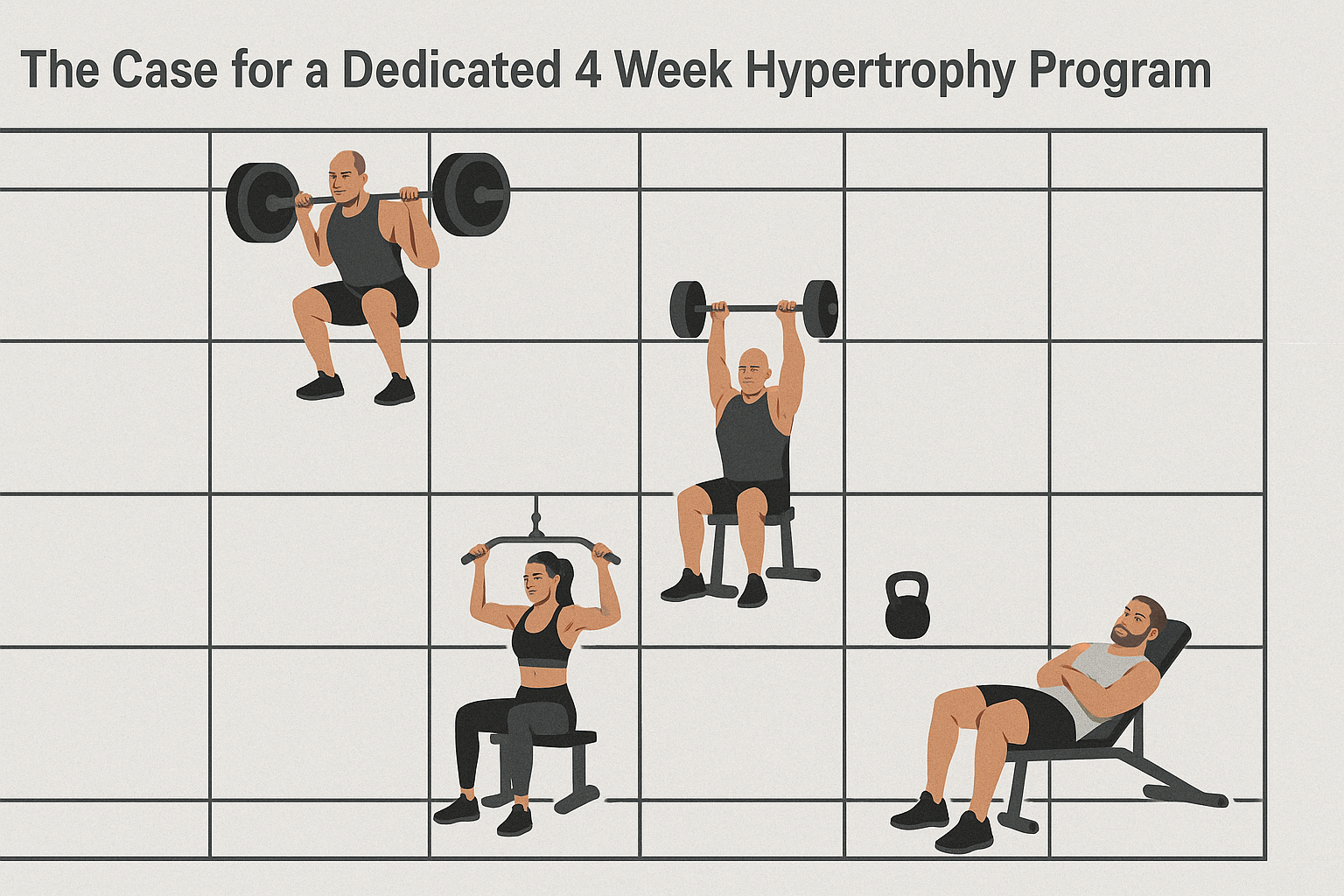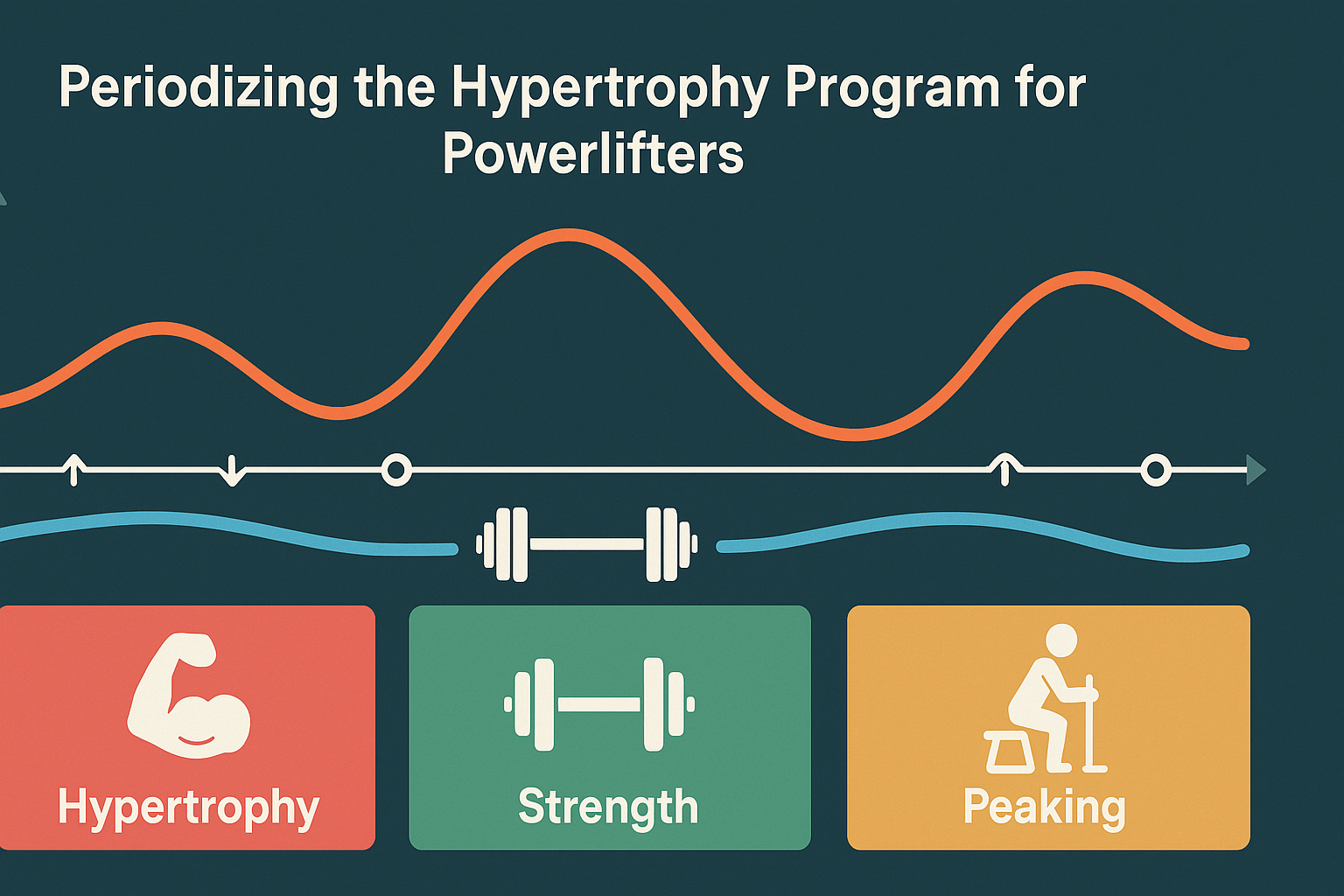Introduction: Rethinking the Powerlifter’s Path to Muscle Growth
For decades, the powerlifting community has thrived on its unwavering commitment to the big three lifts: the squat, bench press, and deadlift. These cornerstones of strength have long defined the essence of powerlifting—raw, focused, and fiercely competitive. Yet as the sport has evolved, so too have the physical demands on the athletes who compete at its highest levels. It is no longer enough to simply lift heavy; modern powerlifters must also possess the muscular development necessary to support high-volume training, prevent injury, and extend their competitive longevity. This is where a strategic hypertrophy program for powerlifters becomes not just beneficial, but essential. By integrating structured hypertrophy work into their training cycles, powerlifters can cultivate a foundation of muscle mass that reinforces their strength pursuits and enhances overall performance.
You may also like: The Ultimate Hypertrophy Workout Program for Building Strength and Size

Understanding Hypertrophy in the Context of Powerlifting
Muscle hypertrophy refers to the physiological process by which muscle fibers increase in size, typically in response to mechanical tension, muscle damage, and metabolic stress. In traditional bodybuilding, hypertrophy is often pursued as an end goal in itself, driven by high-volume training protocols, isolation movements, and strategic pump techniques. In powerlifting, however, hypertrophy plays a supporting role. While the primary objective remains the enhancement of maximal strength, muscular size still provides a critical substrate for force generation, injury resilience, and technical consistency across lifts.
To design an effective hypertrophy program for powerlifters, it is important to differentiate between the two main types of hypertrophy: myofibrillar and sarcoplasmic. Myofibrillar hypertrophy involves the increase in contractile proteins—namely actin and myosin—within the muscle fibers, resulting in denser, stronger muscles. This form of hypertrophy has the most direct carryover to maximal strength, making it a priority for powerlifters. Sarcoplasmic hypertrophy, by contrast, refers to the expansion of the non-contractile elements within the muscle cell, including glycogen stores and intracellular fluid. While this type contributes more to muscle volume than strength, it still plays a valuable role by improving work capacity and buffering fatigue during high-volume training phases.

The Case for a Dedicated 4 Week Hypertrophy Program
Short-term hypertrophy blocks—such as a 4 week hypertrophy program—offer a strategic opportunity for powerlifters to build lean mass while deloading from heavy neurological stress. These blocks are especially effective during off-season periods or after competition prep, when the central nervous system may be fatigued from maximal lifting. By temporarily shifting the training emphasis from absolute strength to muscular growth, lifters can reset their recovery capacity while setting the stage for stronger lifts in future mesocycles.
A 4 week hypertrophy program typically involves increased training volume, reduced loading intensity, and a wider variety of exercises to stimulate growth across multiple planes and angles. This variation not only promotes muscle hypertrophy but also reinforces structural balance by addressing weak points and neglected muscle groups. Another advantage of a focused hypertrophy phase is the enhancement of muscular endurance and energy system efficiency. By operating within higher rep ranges and incorporating shorter rest intervals, athletes can improve their ability to sustain high training workloads—an adaptation that proves invaluable during strength and peaking phases.

Designing the Ideal Hypertrophy Program for Powerlifters
When crafting a hypertrophy program for powerlifters, one must consider several core variables: exercise selection, training frequency, intensity, volume, and progression. Each of these components should be tailored to the powerlifter’s individual needs, competitive goals, and training history. Importantly, the program must remain rooted in specificity, ensuring that hypertrophy adaptations translate to improved performance in the squat, bench, and deadlift.
In terms of exercise selection, compound lifts remain a central pillar. Movements such as front squats, Romanian deadlifts, overhead presses, and weighted dips offer high levels of mechanical tension while promoting hypertrophy in a functional, transferable manner. Accessory movements should then complement these compounds by targeting lagging muscle groups with more localized stimulation. Training frequency during a hypertrophy block often increases to accommodate higher volumes and muscle group exposure. A four- to five-day split can allow for optimal recovery between sessions while still hitting each major muscle group at least twice per week—a frequency shown in research to maximize hypertrophic gains.

Hypertrophy Program for Powerlifters: Recovery and Nutrition Strategies
Recovery is a non-negotiable element of any successful hypertrophy program, particularly for powerlifters who are accustomed to lifting near-maximal loads. The increased volume and frequency characteristic of hypertrophy phases demand a strategic recovery plan that encompasses not only rest and nutrition but also stress management, sleep hygiene, and active recovery modalities.
Nutritionally, a slight caloric surplus is often advantageous during hypertrophy training. This ensures that the body has the energy reserves necessary to support muscle protein synthesis, tissue repair, and hormonal balance. Macronutrient distribution should prioritize protein intake at 1.6–2.2 grams per kilogram of body weight per day. Carbohydrates should form the bulk of energy intake to fuel training sessions and replenish glycogen stores. Sleep plays a central role in hypertrophy, influencing everything from muscle repair to testosterone production and cognitive performance. Aim for 7–9 hours of high-quality sleep per night, with consistent sleep-wake times.

Periodizing the Hypertrophy Program for Powerlifters
Effective periodization is essential to integrate hypertrophy phases within a larger powerlifting training plan. A typical annual plan might alternate between hypertrophy, strength, and peaking phases, each with its own focus and progression strategy. During hypertrophy blocks, the primary goal is to accumulate volume and build muscle mass, which lays the foundation for future strength adaptations. As the cycle progresses into a strength phase, intensity increases while volume decreases, allowing the athlete to convert newly gained muscle into functional strength.
Periodization strategies such as linear, undulating, or block periodization can be applied depending on the athlete’s experience level and competition schedule. For novice lifters, a linear approach—gradually increasing intensity while decreasing volume—is often effective. More advanced athletes may benefit from undulating periodization, which allows for fluctuating intensities and volumes within a microcycle, promoting continued adaptation and preventing plateaus. Incorporating deload weeks between blocks is also critical to facilitate recovery and reset systemic fatigue.

Advanced Techniques for Maximizing Hypertrophy and Strength
Once foundational principles are in place, advanced lifters can experiment with hypertrophy methods that push adaptation even further. Techniques such as rest-pause training, drop sets, cluster sets, and tempo variations add new stimulus to the muscle fibers and challenge metabolic systems. These methods should be used strategically, often as finishers or within accessory work, to avoid excessive fatigue during core lifts.
In addition, manipulating range of motion can provide unique benefits. For instance, deficit deadlifts increase hamstring and glute activation, while pause squats reinforce bottom-end strength and control. These variations not only build muscle but also improve technical proficiency, making them valuable additions to a powerlifter’s hypertrophy toolbox. It is also worth exploring eccentric overloading and blood flow restriction training in controlled environments, under the supervision of experienced coaches.
Frequently Asked Questions: Unlocking Deeper Insights into the Hypertrophy Program for Powerlifters
1. How can powerlifters adjust a hypertrophy program for optimal tendon and joint health?
While muscle hypertrophy is a primary goal, tendon and joint integrity are crucial for long-term powerlifting success. A hypertrophy program for powerlifters should incorporate eccentric-focused training, as slow lowering phases improve tendon resilience. Rotating in lighter accessory work using bands or cables can minimize joint wear while maintaining time under tension. Additionally, including isometric holds at different joint angles during compound lifts can condition connective tissues effectively without overloading the system. Nutritional support, especially adequate collagen, vitamin C, and anti-inflammatory fats, further enhances joint recovery within a rigorous 4 week hypertrophy program.
2. How does training frequency impact results in a 4 week hypertrophy program?
Training frequency directly affects the muscle protein synthesis cycle, and manipulating it strategically can boost gains without overtraining. In a 4 week hypertrophy program, splitting volume across 5–6 sessions per week instead of traditional 3–4 can allow for higher quality reps and less systemic fatigue. This micro-dosing approach, popularized in recent training models, can improve adherence and reduce joint strain. However, it’s important to individualize based on recovery capacity—older lifters or those with high job-related stress may benefit from slightly reduced frequency and increased deload intervals. Using advanced autoregulation strategies like RIR (reps in reserve) ensures that higher frequency still aligns with optimal recovery.
3. What role does deloading play in a hypertrophy program for powerlifters?
Deloading is often overlooked in hypertrophy training, but for powerlifters, it’s non-negotiable. Incorporating strategic deloads every 3–5 weeks helps regulate central nervous system fatigue and prevents stagnation in both strength and muscle growth. In a hypertrophy program for powerlifters, this could mean reducing volume by 40–50% while maintaining intensity or vice versa, depending on the fatigue accumulation model used. Psychological benefits also emerge—many athletes return post-deload with renewed motivation and improved performance. Advanced lifters often pair deloads with technique refinement, using the time to reinforce efficient bar paths and tempo control that carry over to maximal lifts.
4. What are the psychological advantages of following a 4 week hypertrophy program?
A 4 week hypertrophy program introduces a psychologically powerful structure by offering defined short-term goals with tangible progress checkpoints. This format encourages consistency, as athletes can push hard knowing recovery is imminent. Short cycles also reduce training monotony—rotating stimulus every few weeks keeps both the brain and body engaged. For athletes returning from injury or burnout, these compact blocks can restore training confidence and sense of mastery. Additionally, completing a cycle in four weeks creates a rhythm that pairs well with monthly assessments, making it easier to track performance and adapt training parameters.
5. How should diet be modified when entering a hypertrophy program for powerlifters?
Dietary needs shift substantially when transitioning from strength-centric to hypertrophy-focused blocks. In a hypertrophy program for powerlifters, increasing carbohydrate intake by 10–20% supports higher volume workloads and replenishes glycogen. Protein timing becomes more critical—consuming 20–40 grams every 3–4 hours maximizes muscle protein synthesis. Micronutrient density also matters more, especially B-vitamins, magnesium, and zinc, all of which play roles in recovery and energy metabolism. Creatine monohydrate should remain a staple, but some lifters also benefit from citrulline malate or beta-alanine for enhanced pump and endurance during high-rep work. Finally, meal frequency may need to increase slightly to accommodate caloric demands without bloating.
6. What are some advanced overload techniques to consider during a 4 week hypertrophy program?
To maximize adaptations in a 4 week hypertrophy program, lifters can experiment with methods like cluster sets, myo-reps, and mechanical drop sets. Cluster sets allow for heavier weights while extending time under tension by incorporating short intra-set rest periods. Myo-reps—where mini-sets are performed with minimal rest after a top set—can supercharge metabolic stress and hypertrophy without requiring long workouts. Mechanical drop sets leverage exercise variation (e.g., incline to flat to decline press) without changing weights, maintaining intensity while bypassing muscular fatigue. These advanced tools must be programmed sparingly and based on the lifter’s training age to avoid overreaching.
7. How can hypertrophy work enhance powerlifting competition performance?
Although hypertrophy is often viewed separately from competitive powerlifting, targeted muscle growth improves leverage, stability, and bar path control. For instance, increasing quad mass supports knee extension in squats, while larger triceps bolster lockout in the bench press. A hypertrophy program for powerlifters strategically addresses muscular imbalances and weak links that limit heavy attempts. It also promotes structural balance—important for injury prevention and longevity in the sport. Finally, a denser musculature improves neural drive potential during subsequent peaking phases, meaning hypertrophy phases can actually set the stage for greater 1RM outputs months down the line.
8. How should recovery protocols evolve during a 4 week hypertrophy program?
Given the increased training volume, recovery strategies must evolve to sustain performance. In a 4 week hypertrophy program, sleep quality becomes paramount—targeting at least 7.5 to 9 hours per night ensures hormone regulation and muscle repair. Cold water immersion, while helpful post-heavy sessions, may blunt hypertrophy signals if overused, so its application should be strategic. Active recovery methods like mobility work, low-intensity cardio, and contrast showers support circulation and reduce DOMS. Many athletes also incorporate targeted soft tissue work, such as foam rolling or sports massage, on rest days. Finally, monitoring HRV or resting heart rate trends offers insight into cumulative fatigue and recovery needs.
9. Can hypertrophy programs be periodized to support long-term strength peaks?
Yes, and in fact, periodizing a hypertrophy program for powerlifters lays a foundation for progressive strength peaks over the year. This might involve alternating mesocycles—four weeks of hypertrophy followed by a strength block—creating a wave-like progression. The hypertrophy phases serve to expand work capacity and improve muscle cross-sectional area, both prerequisites for strength gains. Over time, this results in higher force output potential without necessitating increased neural fatigue. When coordinated with competitive season timelines, periodized hypertrophy ensures the athlete hits peak form with maximum muscle density and minimal soft tissue strain.
10. What long-term adaptations can be expected after multiple cycles of a 4 week hypertrophy program?
When repeated across several months, a 4 week hypertrophy program fosters significant neuromuscular and morphological adaptations. Muscles not only grow in size but also improve in fiber density and capillarization, enhancing endurance under load. Improved motor unit recruitment emerges as lifters refine movement quality through volume exposure. Hormonal shifts—such as increases in IGF-1 and transient testosterone surges—support sustained anabolic environments. More subtly, the brain learns to push deeper into fatigue thresholds, a psychological adaptation essential for high-stakes strength performance. These cumulative benefits make hypertrophy cycles an indispensable asset in any high-level powerlifting career trajectory.
Conclusion: Building a Stronger Future with Intelligent Hypertrophy Programming
Integrating a well-structured hypertrophy program for powerlifters is no longer a fringe concept but a critical component of high-performance strength development. By embracing the hypertrophic process through intelligent design, strategic periodization, and disciplined recovery, powerlifters can unlock new levels of strength, resilience, and muscularity. The hypertrophy phase, particularly within a 4 week hypertrophy program framework, offers an opportunity to build the physiological foundation necessary for peak performance on the platform.
Whether you are an elite competitor or a dedicated enthusiast, the pathway to long-term progress lies in the balance of brute strength and thoughtful muscle development. With the right tools, the right mindset, and a commitment to continual learning, you can harness the power of hypertrophy to fuel your strongest lifts yet.
Further Reading:
The Ultimate Guide to Powerlifting Programming
4 Weeks to Massive Muscle Program
Why Hypertrophy Training is Key to Any Powerlifting Program





